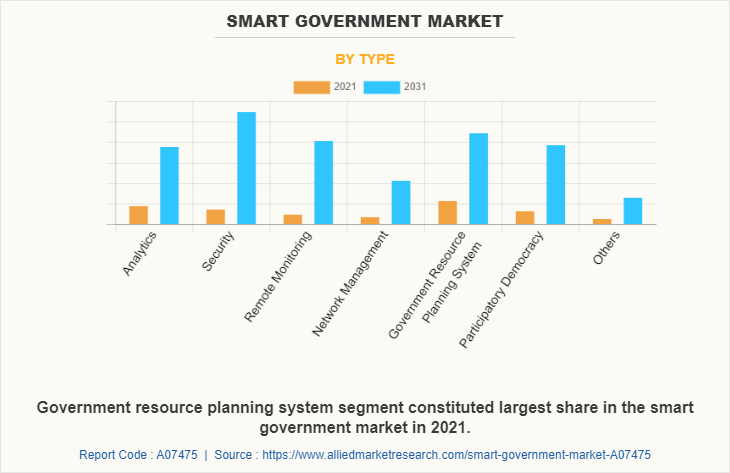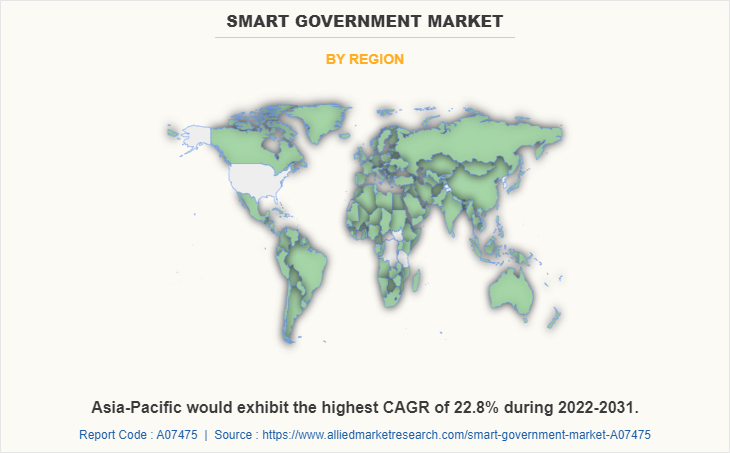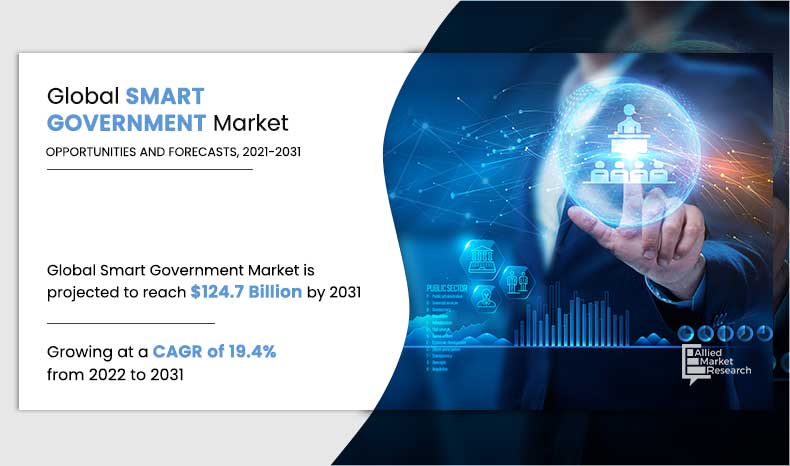Smart Government Market Insights, 2031
The global smart government market was valued at USD 21.9 billion in 2021, and is projected to reach USD 124.7 billion by 2031, growing at a CAGR of 19.4% from 2022 to 2031.
The surge in adoption of technical innovations, rise in government investments in smart government technology, and the high acceptance rate of cloud-based solutions are the factors that drive the growth of the smart government market. In addition, increase in penetration of smartphones coupled with fast internet connectivity, upsurge in preference among consumers for smart governments, and massive adoptions of e-government features in developing countries accelerate the smart government market growth.
Smart government can be described as the use of intelligently networked information and communication (ICT) technology to manage business activities related to government and administration. This portfolio comprises e-government and open-government initiatives as well as big data and open-data initiatives. It deals all about long-term government and administrative activity in the age of the internet of things and the internet of services, which are based on the internet of systems, the internet of people, and the internet of data.
However, rise in data breaches and high costs of the IT infrastructure hamper growth of the market. On the contrary, surge in government initiatives by the government to digitalize their operations is expected to create lucrative opportunities for the market to grow. Moreover, growth in technologies & adoption of cloud in public sector are anticipated to provide potential growth opportunities for the market. By type, the government resource planning system segment attained the highest segment in 2020. This is attributed to the increase in adoption of digital technologies by government for planning the use of resources in an effective way fuels the growth of the market.
However, the remote monitoring segment is forecasted to grow at a significant rate during the forecast period. This is attributed to the aid of linked technology, the development of smart cities has helped to improve the level of living. An IoT-driven ecosystem is increasingly playing a critical role in reducing energy usage and effectively controlling various infrastructure facilities remotely.
The report focuses on growth prospects, restraints, and trends of the smart government market analysis. The study provides Porter’s five forces analysis to understand the impact of various factors such as bargaining power of suppliers, competitive intensity of competitors, threat of new entrants, threat of substitutes, and bargaining power of buyers on the smart government industry outlook.
Segment Review
The smart government market is segmented into component, type, deployment model, and region. By component, the market is categorized into solution and service. Depending on type, it is segregated into analytics, security, remote monitoring, network management, government resource planning system, participatory democracy and others. By deployment model, it is on-premise and cloud. Region wise, the market is analyzed across North America, Europe, Asia-Pacific, and LAMEA.
On the basis of type, the government resource planning system segment attained the highest growth during 2021. This is attributed to the increase in adoption of digital technologies by government for planning the use of resources in an effective way. Furthermore, the surge in reliance on statistical and analytical data generated by the GRP software is fueling the growth of the segment in smart government market.

Region wise, the smart government market size was dominated by North America in 2021. The existence of well-established ICT infrastructure in the North American area has aided in the expansion of the smart government industry in the region

The key players operating in the global smart government market include ABB Ltd., Amazon Web Services, Inc., Avaya Inc., Capgemini S.A., Cisco Systems, Inc., CitizenLab, Decidim, Huawei Technologies Co., Ltd., Imex Systems Inc., Nokia Corporation. These players have adopted various strategies to increase their market penetration and strengthen their position in the industry.
Top Impacting Factors
Increase in demand for digitalization of government operations
Demand for digital media and smart technologies is predicted to rise as a result of technical improvements leading to increasing expenditures in smart government technology, which has been a significant market driver. Additionally, increasing demand for digitalization for legal processes such as making passports, aadhar cards and others by the citizens is compelling governments to digitize the operations.
Moreover, mobile services, such as apps and SMS, make it easier and more targeted for customers to acquire the services they need. These e-participation technologies also promote more citizen cooperation by incorporating citizens in decision-making, policy formulation, budget prioritizing, issue resolution, and service co-design. Furthermore, the increased penetration of smartphones has also contributed to the rising demand for digitalization of various operations. Thus, the increasing demand for digitalization of government operation is driving the growth of the smart government market.
Various advantages provided by smart governments
Smart governments can employ advance analytics to enhance service design and personalize delivery by leveraging data collected from individuals and devices on a regular basis. In addition, digital technologies allow to experiment with new service delivery models, enhance resource management through wiser expenditure, and relate the money spent on programs and services to the outcomes they provide for residents, therefore increasing responsibility and confidence.
Moreover, some governments are already utilizing a virtual workforce to automate normal business procedures, reducing the stress of high-volume, repetitive jobs while also freeing up time and resources to focus on frontline services. This provides better efficiency for the governments and aids in handing the operations effectively. Hence, these advantages are engrossing governments around the world to digitalize. Thus, various advantages provided by smart governments is propelling the growth of the smart government market.
Increasing adoption of cloud technology by governments
Government entities are increasingly using cloud technology as a result of technical breakthroughs. Security is a primary priority for government workloads, and the value delivered by cloud solutions is critical to keeping classified data in government hands. For instance, in March 2019, the city of Los Angeles' IT infrastructure had undergone a significant transformation, with its mainframe being moved to the California Department of Technology's (CDT) state data center in Sacramento.
Moreover, the extreme challenges that government institutions encountered during the pandemic appeared tailor-made for cloud's capabilities. The cloud's immediate scalability had accommodated unexpected spikes in service demand. Cloud services' virtual nature have been able to satisfy the demand to go to remote work promptly. As a result, many government agencies turned to the cloud to address many of the new challenges posed by the pandemic—challenges that often-required scalability to meet unprecedented demand for existing services, agility to set up entirely new programs, and flexibility to support both their customers and their workers remotely. Thus, the increasing adoption of cloud technology by governments is boosting the growth of the smart governmentmarket.
Regional Insights
The smart government market is growing across various regions, driven by the increasing adoption of digital technologies, smart city initiatives, and the need for efficient public services.
North America leads the smart government market, with the U.S. and Canada being key contributors. The region’s advanced technological infrastructure and strong government initiatives for digital transformation are fueling market growth. Governments in North America are increasingly adopting artificial intelligence (AI), big data, and cloud computing to improve public services, enhance citizen engagement, and optimize operations. Key initiatives like smart cities and e-governance platforms are rapidly expanding, particularly in major urban areas.
Europe is another significant player in the smart government market, with countries like the U.K., Germany, and the Netherlands spearheading smart governance initiatives. The European Union has introduced multiple regulations and funding programs to promote digitalization in public sectors, such as the Digital Europe Programme and the Horizon Europe research initiative. European governments are focusing on improving transparency, sustainability, and citizen-centric services through smart technologies, including IoT (Internet of Things) and blockchain for secure and efficient governance.
Asia-Pacific is the fastest-growing region in the smart government market, driven by countries like China, India, Japan, and Singapore. Rapid urbanization, population growth, and the increasing need for efficient governance systems are pushing governments to adopt digital technologies. China and India, in particular, have launched large-scale initiatives such as China's Smart City project and India’s Digital India program, which aim to leverage technology for better governance, urban planning, and public services. Additionally, smart governance is being integrated into disaster management, healthcare, and transportation across the region.
Latin America and the Middle East and Africa are emerging markets for smart government solutions. In Latin America, Brazil and Mexico are investing in smart city initiatives and digital governance platforms to address infrastructure challenges and improve public services. Meanwhile, in the Middle East and Africa, countries like the UAE and Saudi Arabia are making significant strides in smart government through digital transformation initiatives like the UAE’s Vision 2021 and Saudi Arabia’s Vision 2030, which aim to enhance citizen engagement, governance, and public service delivery through technology.
Key Industry Developments
January 2023: The U.S. government launched the “AI for Government” initiative to incorporate artificial intelligence into public services, focusing on improving citizen engagement and operational efficiency in various federal departments. This initiative also emphasizes data analytics to optimize decision-making and public service delivery.
April 2023: The European Union introduced its “Digital Decade” policy framework, aimed at increasing the digital transformation of European governments by 2030. The framework focuses on digitizing public services, increasing internet connectivity, and improving cybersecurity across government institutions to ensure secure, citizen-focused governance.
July 2023: India’s government expanded the Digital India initiative by launching new e-governance platforms that use blockchain and AI for secure, transparent, and efficient public service delivery. The government also announced partnerships with global tech firms to enhance the country’s smart city infrastructure.
August 2023: The UAE government launched the “Smart Dubai 2023” initiative, which integrates AI, IoT, and blockchain technologies into public services. The initiative focuses on enhancing governance, citizen experience, and sustainability through digital technologies, making Dubai a global leader in smart governance.
COVID-19 Impact Analysis
COVID-19 pandemic has a positive impact on the smart government industry, owing to increase in usage and adoption of online & digitalized public sector operations among consumers and government authorities globally. Smart governments are experiencing massive growth as consumers are getting familiar with the digital technologies in the market. Moreover, improved revenue-generating prospects for the IT industry by collaborating with the government and aiding in smart governance provide various growth opportunities for the smart governments market's growth. This, in turn, has become one of the major growth factors for the smart government industry during the global health crisis.
Key Benefits for Stakeholders
- This report provides a quantitative analysis of the market segments, current trends, estimations, and dynamics of the mobile security market analysis from 2021 to 2031 to identify the prevailing smart government market share.
- The market research is offered along with information related to key drivers, restraints, and opportunities.
- Porter's five forces analysis highlights the potency of buyers and suppliers to enable stakeholders make profit-oriented business decisions and strengthen their supplier-buyer network.
- In-depth analysis of the smart government market segmentation assists to determine the prevailing market opportunities.
- Major countries in each region are mapped according to their revenue contribution to the global smart government market forecast.
- Market player positioning facilitates benchmarking and provides a clear understanding of the present position of the market players.
- The report includes the analysis of the regional as well as global smart government market trends, key players, market segments, application areas, and market growth strategies.
Smart Government Market Report Highlights
| Aspects | Details |
| By Type |
|
| By Component |
|
| By Deployment Model |
|
| By Region |
|
| Key Market Players | Imex Systems Inc., Cisco Systems, Inc., Nokia Corporation, CitizenLab, DECIDIM, Huawei Technologies Co. Ltd., Amazon Web Services, Inc., Avaya Inc., Capgemini S.A., ABB Ltd. |
Analyst Review
The input of data from a variety of sources helps governments to plan for digital transformation and the use of smart technology. Moreover, the emergence of technology such as mobile applications, big data analytics, and social media technologies enabled individuals to communicate with the government, accelerates market growth even further. In addition, governments hold vast volumes of information in the form of policies, user records, and initiatives. As a result, having a powerful and reliable storage solution has become crucial for them. This has led to the adoption of cloud technology for storage purposes among public sectors.
The COVID-19 outbreak has a significant impact on the smart government market and has accelerated the adoption of digital services in public sector in order to keep their operation running. Moreover, during this global health crisis, the adoption of smart governments increased in developing nations owing to rise in technological advancements. This, as a result promoted the demand for smart government in various economies all around the globe.
The smart government market is fragmented with the presence of regional vendors such as ABB Ltd., Amazon Web Services, Inc., Avaya Inc., Capgemini S.A., Cisco Systems, Inc., CitizenLab, Decidim, Huawei Technologies Co., Ltd., Imex Systems Inc., Nokia Corporation. Major players operating in this market have witnessed significant adoption of strategies that include business expansion and partnership to reduce supply and demand gap. With rise in awareness & demand for smart government across the globe, major players have collaborated their product portfolio to provide differentiated and innovative products.
The global smart government market was valued at $21.9 billion in 2021 and is projected to reach $124.7 billion by 2031.
The smart government market is projected to grow at a compound annual growth rate of 19.4% from 2022 to 2031.
The key players operating in the smart government market analysis include ABB Ltd., Amazon Web Services, Inc., Avaya Inc., Capgemini S.A., Cisco Systems, Inc., CitizenLab, Decidim, Huawei Technologies Co., Ltd., Imex Systems Inc., Nokia Corporation. These players have adopted various strategies to increase their market penetration and strengthen their position in the industry.
Region wise, the smart government market size was dominated by North America
Demand for digital media and smart technologies has risen as a result of technical improvements, resulting in a spike in expenditures in smart government technologies throughout the world, which is expected to fuel market expansion.
Loading Table Of Content...




